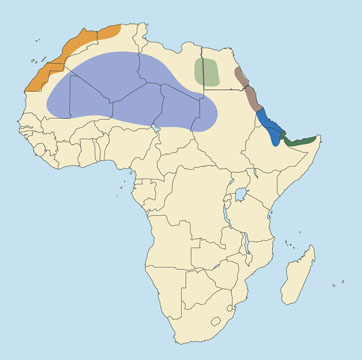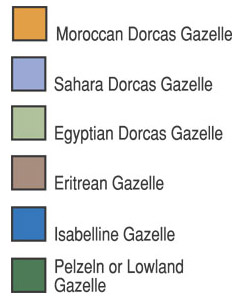 |
 |
Gazella dorcas pelzelni
Gacela de Pelzeln (Sp), Pelzelns-Gazelle (G), Gazelle de Pelzeln (F). Also called lowland gazelle. Named for Austrian zoologist A. von Pelzeln (1825-1891), who was custodian of the Vienna Museum for many years. Both the Pelzeln and Speke gazelles are called dero in Somali.
DESCRIPTION Shoulder height about 25 inches (64 cm). Weight 45-50 pounds (20-23 kg).
The Pelzeln gazelle is about the same size as the isabelline gazelle, and is a little larger than the Speke gazelle. It is distinctive in comparison with other races of dorcas gazelle. The general color is reddish fawn, with the underparts white. A broad, dark reddish flank band-never dusky brown or black as in the Speke gazelle-is usually present, though not always, and its presence or absence does not depend or age or sex. There is a dark reddish blaze on the forehead and upper face, a whitish stripe from the horn base over the eye to the muzzle, a short and indistinct brown cheek stripe below the eye, and no nose spot. The skull is relatively narrow and long. The evenly divergent horns (both sexes) are ringed almost to the tips, rising nearly straight from the head, with only a slight backward curve and an upward or forward bend at the tips.
HABITAT Stony desert plains with little or no bush, at low elevations.
DISTRIBUTION Djibouti (where it is probably the most common antelope), and eastward along the maritime plains of northern Somalia as far as Bosaso. Found only within about 20 miles (32 km) of the seacoast; farther inland it is replaced by the Speke gazelle.
TAXONOMIC NOTES Until recently the Pelzeln gazelle was considered a separate species, and some authorities continue to regard it as such; however, we follow Gentry, Groves and others in treating it as a subspecies of dorcas gazelle.
Some believe that dorcas gazelles from the Danakil region of Ethiopia are intermediate in character between pelzelni and isabella (isabelline gazelle). For record keeping, we treat them as isabella.
STATUS Listed as endangered by the USF&WS (1979).
|





